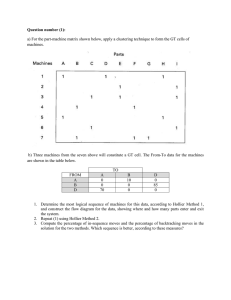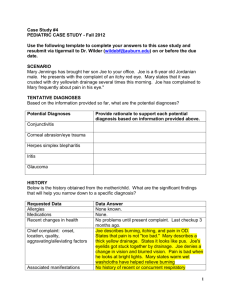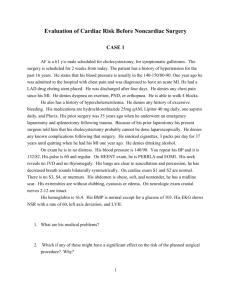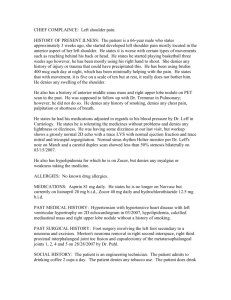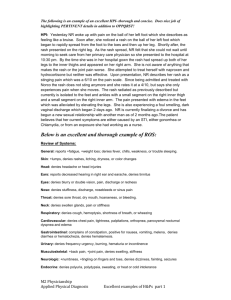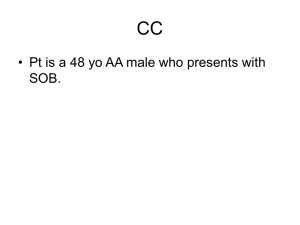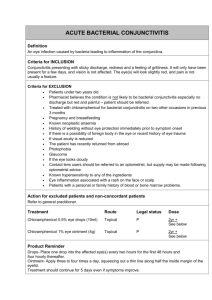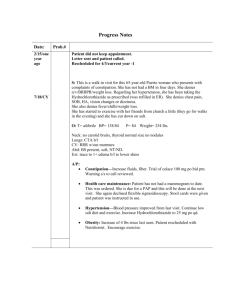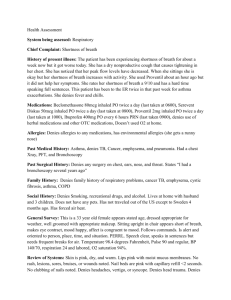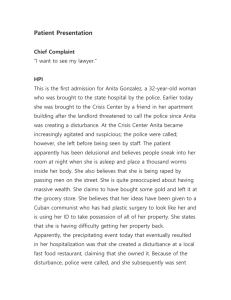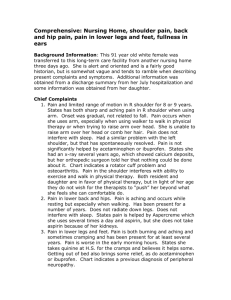SOAP note
advertisement
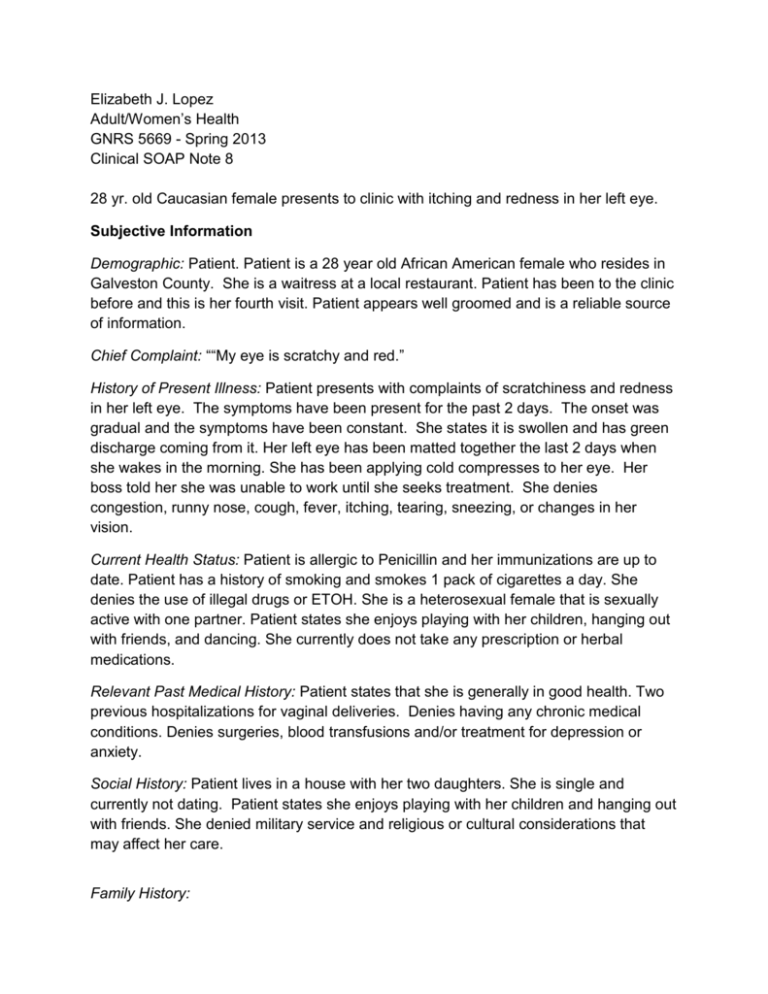
Elizabeth J. Lopez Adult/Women’s Health GNRS 5669 - Spring 2013 Clinical SOAP Note 8 28 yr. old Caucasian female presents to clinic with itching and redness in her left eye. Subjective Information Demographic: Patient. Patient is a 28 year old African American female who resides in Galveston County. She is a waitress at a local restaurant. Patient has been to the clinic before and this is her fourth visit. Patient appears well groomed and is a reliable source of information. Chief Complaint: ““My eye is scratchy and red.” History of Present Illness: Patient presents with complaints of scratchiness and redness in her left eye. The symptoms have been present for the past 2 days. The onset was gradual and the symptoms have been constant. She states it is swollen and has green discharge coming from it. Her left eye has been matted together the last 2 days when she wakes in the morning. She has been applying cold compresses to her eye. Her boss told her she was unable to work until she seeks treatment. She denies congestion, runny nose, cough, fever, itching, tearing, sneezing, or changes in her vision. Current Health Status: Patient is allergic to Penicillin and her immunizations are up to date. Patient has a history of smoking and smokes 1 pack of cigarettes a day. She denies the use of illegal drugs or ETOH. She is a heterosexual female that is sexually active with one partner. Patient states she enjoys playing with her children, hanging out with friends, and dancing. She currently does not take any prescription or herbal medications. Relevant Past Medical History: Patient states that she is generally in good health. Two previous hospitalizations for vaginal deliveries. Denies having any chronic medical conditions. Denies surgeries, blood transfusions and/or treatment for depression or anxiety. Social History: Patient lives in a house with her two daughters. She is single and currently not dating. Patient states she enjoys playing with her children and hanging out with friends. She denied military service and religious or cultural considerations that may affect her care. Family History: Father –alive with no known medical problems Mother- alive with no known medical problems Brother- alive with no known medical problems Children- alive and well Medications: none ROS of Relevant Systems: General: Overall healthy Head/Eyes: Denies any changes in vision, diplopia, headache, or trauma to the eyes ENT: Denies any pain, sore throat, rhinorrhea or vertigo, or loss of balance Cardiovascular: Denies chest pain, pressure or palpitations Respiratory: Denies cough or shortness of breath Gastrointestinal: Denies nausea, vomiting, diarrhea, constipation, heartburn or abdominal pain Patient explanatory Model “I think I have pink eye.” Objective Information Physical Exam: BP: 105/64 T: 98.5 F P: 68 R: 19 Ht: 5’6’’ Wt: 125lbs General: Alert and oriented x3, no acute distress. HEENT: NC/AT, PERRLA, MMM, trachea midline; neck supple, external ears appeared normal, B/L tympanic membrane intact, oropharynx clear with no lesions or erythema; No palpable/enlarged lymph nodes; Left eye erythematous with mucopurulent discharge; matted eyelid; normal visual acuity; cornea clear bilaterally Cardiac: RRR, Normal S1/S2, no murmur noted Pulmonary: CTAB, symmetrical chest expansion Skin: No rashes, good turgor, membranes pink and moist Medical Diagnosis: Bacterial Conjunctivitis The onset is gradual, begins unilaterally and often becomes bilateral. The patient usually reports a scratchy sensation instead of pain (Dains, Baumann, & Scheibel, 2012). Bacterial conjunctivitis most commonly occurs in the winter and fall. A sensation of having a foreign body in the eye is common with bacterial conjunctivitis. Conjunctivitis never accompanies a change in vision. If there is a change in vision with conjunctival symptoms, this is a red flag (Hollier & Hensley, 2011). Differential Diagnosis: 1. Viral Conjunctivitis Assessment findings with viral conjunctivitis include: profuse tearing, burning, concurrent upper respiratory infection (Hollier & Hensley, 2011). The conjunctiva is brilliant red, diffuse, and peripheral. Edema may also be present (Dunphy, Winland-Brown, Porter, & Thomas, 2011). 2. Iritis Presents with marked conjunctival injection, mainly around the cornea; it is unilateral, without discharge. The patient has moderate to severe pain (Dunphy et.al, 2011). 3. Allergic conjunctivitis Assessment findings include: severe itching, tearing, sneezing & rhinitis. It is bilateral with a watery discharge. This is a seasonal occurrence, most common in fall and spring. It is caused by environmental allergies or cosmetics (Hollier & Hensley, 2011). Plan: 1. Diagnostic: Check visual acuity and usually no other diagnostic studies (Hollier & Hensley, 2011). 2. Therapeutic: Erythromycin 0.5% ointment apply BID(used d/t PCN allergy); warm compresses 3. Education: Good hand-eye hygiene, use clean wash cloths each time face is washed, change pillowcase on bed daily until resolved, instruct patient on how to apply ointment, do not wear contact lenses, and discard any eye makeup. Patient instructed to also apply medication into the currently unaffected eye prophylactically. 4. Follow-up: Telephone or office follow-up in 24 hours to assess effectiveness of treatment; RTC if no improvement in 5 days or is symptoms worsen References American Diabetes Association. (2013). Retrieved from http://www.diabetes.org/ Dains J., Baumann L., Scheibel P. (2012). In Advanced health assessment and clinical diagnosis in primary care (4th ed). St. Louis, MO: Elsevier. Dunphy, L. M., Winland-Brown, J. E., Porter, B. O., & Thomas, d. J. (Eds.). (2011). Primary care the art and science of advanced practice nursing (3rd ed.). Philadelphia: F.A. Davis. Hollier, A. & Hensley R. (2011). Clinical Guidelines in Primary Care: A Reference and Review Book. Lafayette, LA:Advanced Practice Education Associates, Inc. McCulloch, D. (2012). Diagnosis of Diabetes Mellitus. Retrieved from http://www.uptodate.com/contents/diagnosis-of-diabetesmellitus?source=related_link

